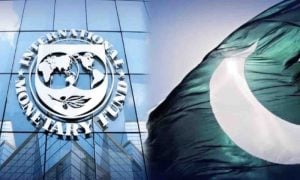Key points
- US was India’s top export destination in 2024
- Indian shipments worth $87.3 billion went to the US last year
- Russia accounted for nearly 36pc of India’s total crude oil imports in 2024
- Buying Russian oil saved India billions of dollars on import costs
ISLAMABAD: US tariffs of 50 per cent took effect Wednesday on many Indian products, doubling an existing duty as President Donald Trump sought to punish New Delhi for buying Russian oil.
Trump has raised pressure on India over the energy transactions, a key source of revenue for Moscow’s war in Ukraine, as part of a campaign to end the conflict.
The latest salvo strains US-India ties, giving New Delhi fresh incentive to improve relations with Beijing.
Fresh duties
While Trump has slapped fresh duties on allies and competitors alike since returning to the presidency in January, this 50-per cent level is among the highest that US trading partners face.
Looks like the Trump’s 50% tariffs directly targets India’s job-creating sectors with Very High impact. The select electronics carveouts will not be enough to stave off major crunches on orders for Indian textiles, chemicals, and manufactured goods pic.twitter.com/FoML8pqQcn
— Satvik Pendyala | 彭尚威 | సాత్విక్ | सात्विक (@Satvik_Pen) August 26, 2025
Crucially, however, exemptions remain for sectors that could be hit with separate levies — like pharmaceuticals and computer chips.
The Trump administration has launched investigations into these and other sectors that could culminate in further duties. Smartphones are in the list of exempted products as well.
Industries that have already been singled out, such as steel, aluminium and automobiles, are similarly spared these countrywide levies.
The United States was India’s top export destination in 2024, with shipments worth $87.3 billion.
Akin to trade embargo?
But analysts have cautioned that a 50-per-cent duty is akin to a trade embargo and is likely to harm smaller firms.
https://x.com/TahraHoops/status/1960557385207967986
Exporters of textiles, seafood and jewellery were already reporting cancelled US orders and losses to rivals such as Bangladesh and Vietnam, raising fears of heavy job cuts.
“Eroded trust”
New Delhi has criticised Washington’s move as “unfair, unjustified and unreasonable,” according to AFP.
Modi earlier vowed self-reliance as well, pledging to defend his country’s interests.
The foreign ministry previously said India had begun importing oil from Russia as traditional supplies were diverted to Europe over Russia’s invasion of Ukraine.
It noted that Washington actively encouraged such imports at the time to strengthen stability in the global energy market.
Russia accounted for nearly 36 per cent of India’s total crude oil imports in 2024. Buying Russian oil saved India billions of dollars on import costs, keeping domestic fuel prices relatively stable.
India’s “role in the bloodshed”
But the Trump administration held firm on its tariff plans in the lead-up to Wednesday’s deadline.
Trump’s trade adviser Peter Navarro told reporters last week that “India doesn’t appear to want to recognize its role in the bloodshed.”
“It’s cozying up to Xi Jinping,” Navarro added, referring to the Chinese president.
Highest tariffs
Wendy Cutler, senior vice president at the Asia Society Policy Institute, told AFP: “One of the most troubling developments in the Trump tariff saga is how India moved from a promising candidate for an early trade deal to a nation facing among the highest tariffs imposed by the US against any trading partner.”
Cutler, a former US trade official, said India has been reforming and opening despite its history of being tough on trade matters.
But these trends may be called into question with Trump’s sharp levies.
“The high tariffs have quickly eroded trust between the two countries, which could take years to rebuild,” she said.
Trump has used tariffs as a tool for addressing everything from what Washington deems as unfair trade practices to trade imbalances.

























